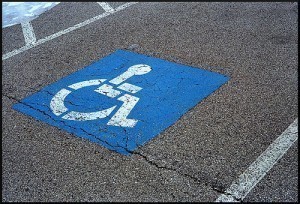Dimensions of a Handicap Parking Space
Designed primarily for people with dis abilities, a handicap parking space is one of the most important features of the parking lots of different kinds of business establishments and other commercial buildings. Only cars with a disabled badge, disabled placard or handicapped permit are allowed to park in these designated spaces. These permits cover any individual whose mobility is affected significantly by infirmity, disability or illness. Besides these many interesting facts, it is also important to know the dimensions of a handicap parking space.
abilities, a handicap parking space is one of the most important features of the parking lots of different kinds of business establishments and other commercial buildings. Only cars with a disabled badge, disabled placard or handicapped permit are allowed to park in these designated spaces. These permits cover any individual whose mobility is affected significantly by infirmity, disability or illness. Besides these many interesting facts, it is also important to know the dimensions of a handicap parking space.
The Standard Size of a Handicap Parking Space
In the United States, the width of standard handicap parking space is 96 inches. Furthermore, it must have an easy access to a 5-foot wide loading area. Each parking lot must have van accessible spots because vans are the preferred means of transporting handicapped individuals from one particular point to another. Marked with a sign that states ‘Van Accessible,’ it must have a loading area of about 8 feet. In terms of vertical clearance, the standard measurement is 98 inches. It is possible for two parking spaces to share one loading zone, as long as the van accessible space is at least 8 feet.
Additional Facts and Other Interesting Details
The American with Disabilities Act Accessibility Guidelines covers the rules and specifications of reserved spaces for handicapped individuals in the United States. There are two main types of disabled parking permits released in the country, one of which is in the form of a placard while the other one takes the form of a marked license plate. Disabled drivers commonly use plates, which are attached to their personal vehicles. On the contrary, the placard is a transferable form of permit, which can be used from one specific vehicle to another as long as it is carrying a disabled person.
In order to obtain these permits, it is necessary to pass certain medical requirements. Based on the general rules, these include individuals who use different kinds of assistive devices including a cane, crutches or a wheelchair. Other conditions and disabilities covered by these rules are respiratory problems and cardiovascular conditions. Meanwhile, states like New York and Virginia consider developmental disabilities or mental illness as part of the requirements to obtain permits.
Other countries implement their own rules with regards to the use of handicap parking spaces. In Scotland, the authority to inspect a Blue Badge belongs to traffic wardens, police officers and parking attendants. In the Republic of Ireland, the Disabled Drivers Association of Ireland is responsible for issuing Disabled Persons’ Parking Permits. In Denmark, some parking lots require other things aside from a Blue Badge. An example of these is the Disabled Person’s Parking Disk.





